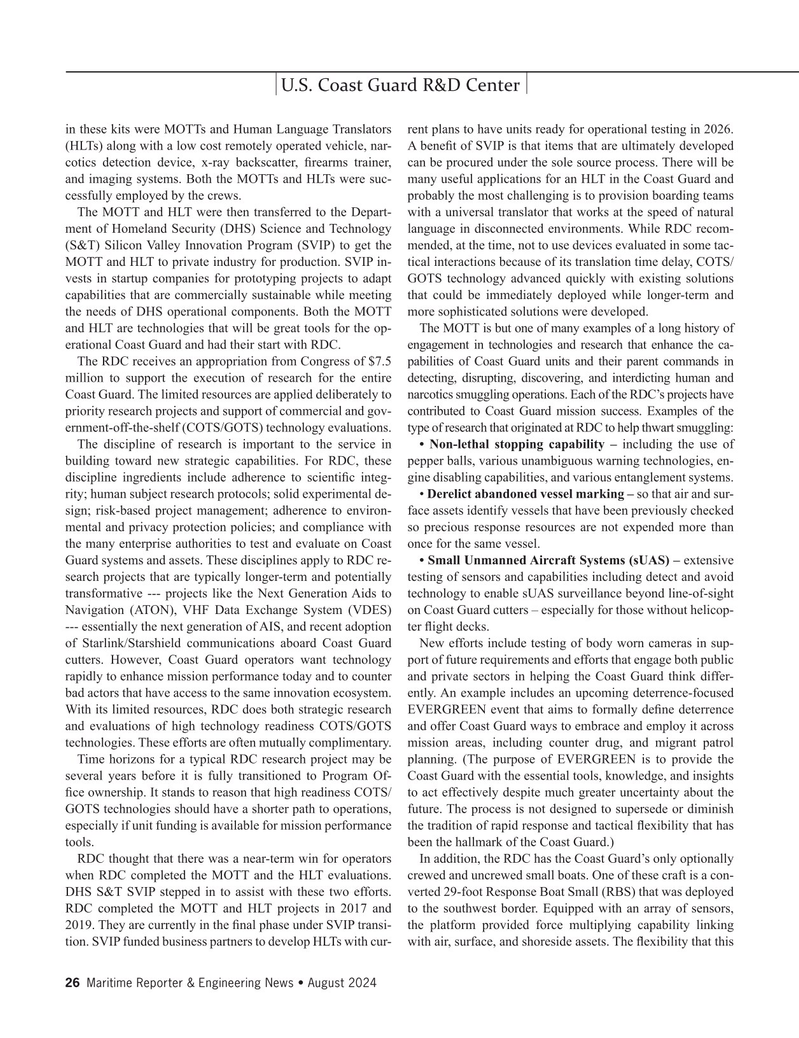
Page 26: of Maritime Reporter Magazine (August 2024)
Read this page in Pdf, Flash or Html5 edition of August 2024 Maritime Reporter Magazine
U.S. Coast Guard R&D Center in these kits were MOTTs and Human Language Translators rent plans to have units ready for operational testing in 2026. (HLTs) along with a low cost remotely operated vehicle, nar- A bene? t of SVIP is that items that are ultimately developed cotics detection device, x-ray backscatter, ? rearms trainer, can be procured under the sole source process. There will be and imaging systems. Both the MOTTs and HLTs were suc- many useful applications for an HLT in the Coast Guard and cessfully employed by the crews. probably the most challenging is to provision boarding teams
The MOTT and HLT were then transferred to the Depart- with a universal translator that works at the speed of natural ment of Homeland Security (DHS) Science and Technology language in disconnected environments. While RDC recom- (S&T) Silicon Valley Innovation Program (SVIP) to get the mended, at the time, not to use devices evaluated in some tac-
MOTT and HLT to private industry for production. SVIP in- tical interactions because of its translation time delay, COTS/ vests in startup companies for prototyping projects to adapt GOTS technology advanced quickly with existing solutions capabilities that are commercially sustainable while meeting that could be immediately deployed while longer-term and the needs of DHS operational components. Both the MOTT more sophisticated solutions were developed. and HLT are technologies that will be great tools for the op- The MOTT is but one of many examples of a long history of erational Coast Guard and had their start with RDC. engagement in technologies and research that enhance the ca-
The RDC receives an appropriation from Congress of $7.5 pabilities of Coast Guard units and their parent commands in million to support the execution of research for the entire detecting, disrupting, discovering, and interdicting human and
Coast Guard. The limited resources are applied deliberately to narcotics smuggling operations. Each of the RDC’s projects have priority research projects and support of commercial and gov- contributed to Coast Guard mission success. Examples of the ernment-off-the-shelf (COTS/GOTS) technology evaluations. type of research that originated at RDC to help thwart smuggling:
The discipline of research is important to the service in • Non-lethal stopping capability – including the use of building toward new strategic capabilities. For RDC, these pepper balls, various unambiguous warning technologies, en- discipline ingredients include adherence to scienti? c integ- gine disabling capabilities, and various entanglement systems. rity; human subject research protocols; solid experimental de- • Derelict abandoned vessel marking – so that air and sur- sign; risk-based project management; adherence to environ- face assets identify vessels that have been previously checked mental and privacy protection policies; and compliance with so precious response resources are not expended more than the many enterprise authorities to test and evaluate on Coast once for the same vessel.
Guard systems and assets. These disciplines apply to RDC re- • Small Unmanned Aircraft Systems (sUAS) – extensive search projects that are typically longer-term and potentially testing of sensors and capabilities including detect and avoid transformative --- projects like the Next Generation Aids to technology to enable sUAS surveillance beyond line-of-sight
Navigation (ATON), VHF Data Exchange System (VDES) on Coast Guard cutters – especially for those without helicop- --- essentially the next generation of AIS, and recent adoption ter ? ight decks. of Starlink/Starshield communications aboard Coast Guard New efforts include testing of body worn cameras in sup- cutters. However, Coast Guard operators want technology port of future requirements and efforts that engage both public rapidly to enhance mission performance today and to counter and private sectors in helping the Coast Guard think differ- bad actors that have access to the same innovation ecosystem. ently. An example includes an upcoming deterrence-focused
With its limited resources, RDC does both strategic research EVERGREEN event that aims to formally de? ne deterrence and evaluations of high technology readiness COTS/GOTS and offer Coast Guard ways to embrace and employ it across technologies. These efforts are often mutually complimentary. mission areas, including counter drug, and migrant patrol
Time horizons for a typical RDC research project may be planning. (The purpose of EVERGREEN is to provide the several years before it is fully transitioned to Program Of- Coast Guard with the essential tools, knowledge, and insights ? ce ownership. It stands to reason that high readiness COTS/ to act effectively despite much greater uncertainty about the
GOTS technologies should have a shorter path to operations, future. The process is not designed to supersede or diminish especially if unit funding is available for mission performance the tradition of rapid response and tactical ? exibility that has tools. been the hallmark of the Coast Guard.)
RDC thought that there was a near-term win for operators In addition, the RDC has the Coast Guard’s only optionally when RDC completed the MOTT and the HLT evaluations. crewed and uncrewed small boats. One of these craft is a con-
DHS S&T SVIP stepped in to assist with these two efforts. verted 29-foot Response Boat Small (RBS) that was deployed
RDC completed the MOTT and HLT projects in 2017 and to the southwest border. Equipped with an array of sensors, 2019. They are currently in the ? nal phase under SVIP transi- the platform provided force multiplying capability linking tion. SVIP funded business partners to develop HLTs with cur- with air, surface, and shoreside assets. The ? exibility that this 26 Maritime Reporter & Engineering News • August 2024
MR #8 (18-33).indd 26 MR #8 (18-33).indd 26 8/8/2024 10:47:19 AM8/8/2024 10:47:19 AM

 25
25

 27
27
